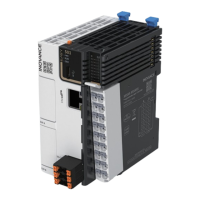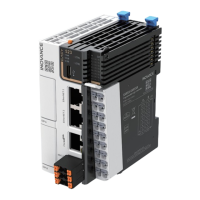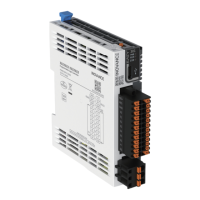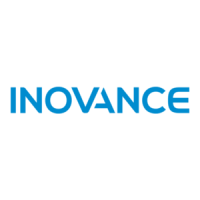Do you have a question about the Inovance Easy320 and is the answer not in the manual?
Overview of the Easy320 series PLC, its features, and communication capabilities.
Lists the certifications, directives, and standards the product adheres to.
General safety warnings and responsibility disclaimer for using the product.
Explains DANGER, WARNING, and CAUTION levels and their meaning.
Provides essential safety practices related to product illustrations and protective guards.
Critical safety advice for installation, including environmental and electrical hazards.
Safety guidelines for electrical wiring, grounding, and power handling to prevent shocks.
Essential safety checks before and after powering on the equipment to prevent damage or injury.
Safety guidelines for operating the PLC, covering temperature and physical contact.
Safety procedures for maintenance, emphasizing power disconnection and qualified personnel.
Safety protocols for repairs, including warranty considerations and part replacement.
Guidelines for safe and environmentally friendly disposal and recycling of the equipment.
Details the PLC model designation and information present on the product nameplate.
Covers program capacity, speed, operations, and communication features of the PLC.
Details power input requirements, protection, and hot-plugging for the PLC.
Specifies types, modes, and voltage classes for the PLC's digital inputs.
Details types, modes, and voltage classes for the PLC's digital outputs.
Defines the required environmental conditions for proper PLC installation and operation.
Specifies acceptable installation orientations and derating limits based on ambient temperature.
Recommends the best position for horizontal installation, including clearances for cooling.
Illustrates alternative mounting orientations and their clearance requirements.
Step-by-step guide to mounting the main controller on a DIN rail.
Instructions for connecting extension modules to the master unit via rails.
Procedure for safely detaching modules from the DIN rail assembly.
Diagram showing the assignment of terminals for inputs, outputs, and power.
Wiring diagram and precautions for SINK type input signal connections.
Wiring diagram and internal circuit for SOURCE type input signal connections.
Overview of how the PLC connects to various systems via Ethernet and other communication interfaces.
Information on selecting appropriate cables and connectors for communication interfaces.
Guides on connecting communication cables, including RS485 and Ethernet ports.
Guidelines for RS485 bus setup, including cable type, termination, and topology.
Instructions on how to initiate and terminate PLC operation.
Steps for programming user applications using an SD card via the TF extension card.
Procedure for updating the PLC's firmware using an SD card.
Overview of the Easy320 series PLC, its features, and communication capabilities.
Lists the certifications, directives, and standards the product adheres to.
General safety warnings and responsibility disclaimer for using the product.
Explains DANGER, WARNING, and CAUTION levels and their meaning.
Provides essential safety practices related to product illustrations and protective guards.
Critical safety advice for installation, including environmental and electrical hazards.
Safety guidelines for electrical wiring, grounding, and power handling to prevent shocks.
Essential safety checks before and after powering on the equipment to prevent damage or injury.
Safety guidelines for operating the PLC, covering temperature and physical contact.
Safety procedures for maintenance, emphasizing power disconnection and qualified personnel.
Safety protocols for repairs, including warranty considerations and part replacement.
Guidelines for safe and environmentally friendly disposal and recycling of the equipment.
Details the PLC model designation and information present on the product nameplate.
Covers program capacity, speed, operations, and communication features of the PLC.
Details power input requirements, protection, and hot-plugging for the PLC.
Specifies types, modes, and voltage classes for the PLC's digital inputs.
Details types, modes, and voltage classes for the PLC's digital outputs.
Defines the required environmental conditions for proper PLC installation and operation.
Specifies acceptable installation orientations and derating limits based on ambient temperature.
Recommends the best position for horizontal installation, including clearances for cooling.
Illustrates alternative mounting orientations and their clearance requirements.
Step-by-step guide to mounting the main controller on a DIN rail.
Instructions for connecting extension modules to the master unit via rails.
Procedure for safely detaching modules from the DIN rail assembly.
Diagram showing the assignment of terminals for inputs, outputs, and power.
Wiring diagram and precautions for SINK type input signal connections.
Wiring diagram and internal circuit for SOURCE type input signal connections.
Overview of how the PLC connects to various systems via Ethernet and other communication interfaces.
Information on selecting appropriate cables and connectors for communication interfaces.
Guides on connecting communication cables, including RS485 and Ethernet ports.
Guidelines for RS485 bus setup, including cable type, termination, and topology.
Instructions on how to initiate and terminate PLC operation.
Steps for programming user applications using an SD card via the TF extension card.
Procedure for updating the PLC's firmware using an SD card.
| Series | Easy |
|---|---|
| Product Type | Compact PLC |
| Model | Easy320 |
| Manufacturer | Inovance |
| Analog Inputs | 2 |
| Analog Outputs | 1 |
| Power Supply | 24V DC |
| Relative Humidity | 5% to 95% (non-condensing) |
| Protection Class | IP20 |
| Type | PLC |
| Communication Ports | RS232, RS485 |











